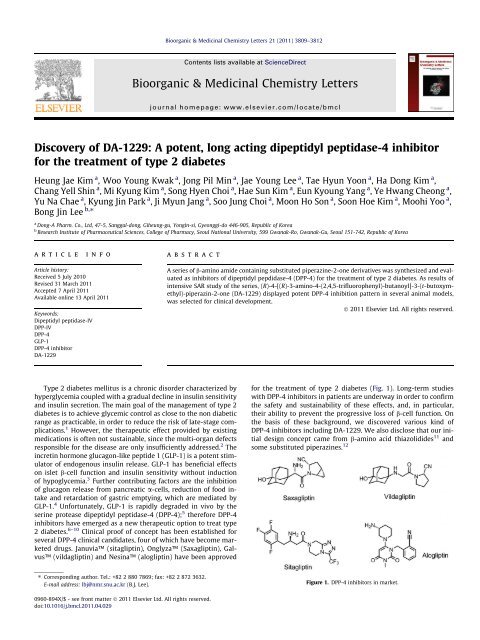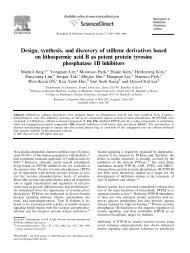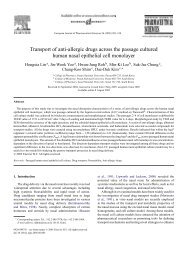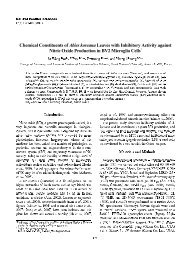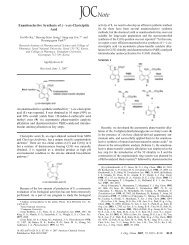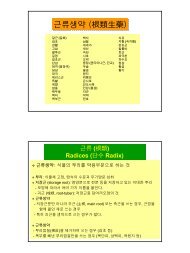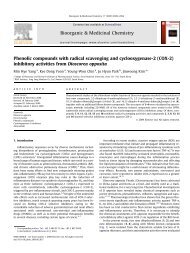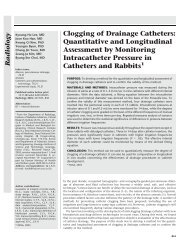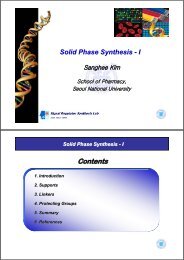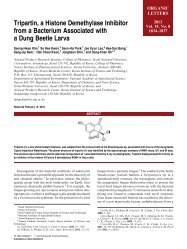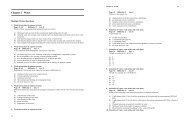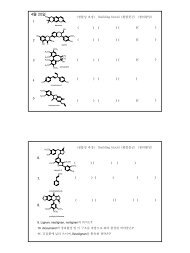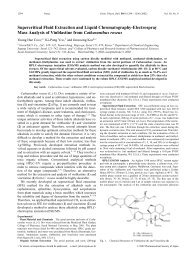Bioorganic & Medicinal Chemistry Letters
Bioorganic & Medicinal Chemistry Letters
Bioorganic & Medicinal Chemistry Letters
Create successful ePaper yourself
Turn your PDF publications into a flip-book with our unique Google optimized e-Paper software.
<strong>Bioorganic</strong> & <strong>Medicinal</strong> <strong>Chemistry</strong> <strong>Letters</strong> 21 (2011) 3809–3812Contents lists available at ScienceDirect<strong>Bioorganic</strong> & <strong>Medicinal</strong> <strong>Chemistry</strong> <strong>Letters</strong>journal homepage: www.elsevier.com/locate/bmclDiscovery of DA-1229: A potent, long acting dipeptidyl peptidase-4 inhibitorfor the treatment of type 2 diabetesHeung Jae Kim a , Woo Young Kwak a , Jong Pil Min a , Jae Young Lee a , Tae Hyun Yoon a , Ha Dong Kim a ,Chang Yell Shin a , Mi Kyung Kim a , Song Hyen Choi a , Hae Sun Kim a , Eun Kyoung Yang a , Ye Hwang Cheong a ,Yu Na Chae a , Kyung Jin Park a , Ji Myun Jang a , Soo Jung Choi a , Moon Ho Son a , Soon Hoe Kim a , Moohi Yoo a ,Bong Jin Lee b,⇑a Dong-A Pharm. Co., Ltd, 47-5, Sanggal-dong, Giheung-gu, Yongin-si, Gyeonggi-do 446-905, Republic of Koreab Research Institute of Pharmaceutical Sciences, College of Pharmacy, Seoul National University, 599 Gwanak-Ro, Gwanak-Gu, Seoul 151-742, Republic of KoreaarticleinfoabstractArticle history:Received 5 July 2010Revised 31 March 2011Accepted 7 April 2011Available online 13 April 2011Keywords:Dipeptidyl peptidase-IVDPP-IVDPP-4GLP-1DPP-4 inhibitorDA-1229A series of b-amino amide containing substituted piperazine-2-one derivatives was synthesized and evaluatedas inhibitors of dipeptidyl pepdidase-4 (DPP-4) for the treatment of type 2 diabetes. As results ofintensive SAR study of the series, (R)-4-[(R)-3-amino-4-(2,4,5-trifluorophenyl)-butanoyl]-3-(t-butoxymethyl)-piperazin-2-one(DA-1229) displayed potent DPP-4 inhibition pattern in several animal models,was selected for clinical development.Ó 2011 Elsevier Ltd. All rights reserved.Type 2 diabetes mellitus is a chronic disorder characterized byhyperglycemia coupled with a gradual decline in insulin sensitivityand insulin secretion. The main goal of the management of type 2diabetes is to achieve glycemic control as close to the non diabeticrange as practicable, in order to reduce the risk of late-stage complications.1 However, the therapeutic effect provided by existingmedications is often not sustainable, since the multi-organ defectsresponsible for the disease are only insufficiently addressed. 2 Theincretin hormone glucagon-like peptide 1 (GLP-1) is a potent stimulatorof endogenous insulin release. GLP-1 has beneficial effectson islet b-cell function and insulin sensitivity without inductionof hypoglycemia. 3 Further contributing factors are the inhibitionof glucagon release from pancreatic a-cells, reduction of food intakeand retardation of gastric emptying, which are mediated byGLP-1. 4 Unfortunately, GLP-1 is rapidly degraded in vivo by theserine protease dipeptidyl peptidase-4 (DPP-4); 5 therefore DPP-4inhibitors have emerged as a new therapeutic option to treat type2 diabetes. 6–10 Clinical proof of concept has been established forseveral DPP-4 clinical candidates, four of which have become marketeddrugs. Januvia (sitagliptin), Onglyza (Saxagliptin), Galvus(vildagliptin) and Nesina (alogliptin) have been approvedfor the treatment of type 2 diabetes (Fig. 1). Long-term studieswith DPP-4 inhibitors in patients are underway in order to confirmthe safety and sustainability of these effects, and, in particular,their ability to prevent the progressive loss of b-cell function. Onthe basis of these background, we discovered various kind ofDPP-4 inhibitors including DA-1229. We also disclose that our initialdesign concept came from b-amino acid thiazolidides 11 andsome substituted piperazines. 12⇑ Corresponding author. Tel.: +82 2 880 7869; fax: +82 2 872 3632.E-mail address: lbj@nmr.snu.ac.kr (B.J. Lee).Figure 1. DPP-4 inhibitors in market.0960-894X/$ - see front matter Ó 2011 Elsevier Ltd. All rights reserved.doi:10.1016/j.bmcl.2011.04.029
3810 H. J. Kim et al. / Bioorg. Med. Chem. Lett. 21 (2011) 3809–3812Scheme 1. Overall design of b-amino amide containing substituted piperazine-2-one derivatives. Reagents: (a) EDC, HOBt, DIPEA/DMF or MC; (b) HCl in ether/MeOH.As shown in Scheme 1, the target compound 4 and 5 were preparedfrom commercial Boc protected b-amino acid 1 and substitutedheterocyclic amine 2 using standard peptide couplingconditions followed by deprotection of amine.The substituted heterocyclic amine 8 was prepared as shown inScheme 2. Commercial Boc-protected piperazin-2-one (6) was coupledwith alkyl or aryl halide to give compound 7, respectively.Deprotection of Boc derivatives 7 by treatment with hydrogenchloride in ether provided compound 8.As shown in Table 1, introduction of the simple methyl 4a resultedin DPP-IV inhibitory activity with an IC 50 value of around100 nM. Substitution of pyridine 4b or non aromatic replacement4e showed decreased activity compared to methyl substitution.In case of five-membered hetero fusion ring 4d and bi-phenyl 4cincreased potency by twofold than methyl. We concluded thatthere were limitations of activity elevation and the essential moietymight be the benzyl 4f which is possible to make hydrophobicinteraction with side chain of Phe357 13,14,16 as shown in Figure 2.So, we tried to study more about benzyl moiety in that positionand then various other substituents were introduced.As shown in Table 2, there was no effect on activity according toposition and size of halogens (4m, 4n, 4o, 4p; 30 nM). In the caseof nitro group, ortho- 4h is threefold more potent than para- 4g.WeScheme 2. Reagents: (a) R 1 Br, NaH, or R 1 Br/DMF, Pd(OAc) 2 , DPPF, KO-t-Bu, THF; (b)HCl in ether/MeOH.Table 1DPP-4 inhibition activities of various substituted compound 4FFFNH 2 ONNR 1OFigure 2. Docking structure of 4f in the active site (from 1X70) of DPP-4.Trifluorophenyl ring is energetically stabilized in the hydrophobic pocket formedby Tyr547, Tyr662 and Tyr666. The amine group forms H-bond with side chain ofGlu205, Tyr662. Phenyl ring of 4f interacts with the side chain of Phe357 and formsedge-phase pi–pi interaction.Table 2DPP-4 inhibition activities of various substituted compound 4FFFNH 2 ONNR 1OCompound R 1 DPP-4 IC 50 15 (nM)4a 92.64bN3114c 44.84dNNN42.74eNO1164f 54.1Compound R 1 DPP-4 IC 50 (nM)4g 4-Nitro-benzyl 38.54h 2-Nitro-benzyl 13.74i 2-Cyano-benzyl 48.94j 2-Trifluoromethyl-benzyl 50.74k 4-Ethyl-benzyl 38.94l 4-Methoxy-benzyl 33.94m 4-Fluoro-benzyl 33.84n 4-Iodo-benzyl 30.84o 3-Chloro-benzyl 26.74p 2-Chloro-benzyl 29.04q 2-Nitro-4,5-dimethoxy-benzyl 7.40
H. J. Kim et al. / Bioorg. Med. Chem. Lett. 21 (2011) 3809–3812 3811Table 3DPP-4 inhibition activities of chiral substituted compound 5FFFNH 2 ONCompound X R 2 DPP-4 IC 50 (nM)5a O H 125b O Methyl 7.45c O Ethyl 4.35d O Cyclopentyl 1.75e O Isopropyl 2.25f O tert-Butyl 0.95g N Ethylmethyl 175h N Diethyl 115i N –(CH 2 CH 2 ) 2 O 5.25j S tert-Butyl 1.3R 2achieved with an IC 50 value of around 10 nM, so further investigationwas conducted with ortho-nitro group. Replacement of nitrogroup to electron-withdrawing cyano 4i or trifluoromethyl 4j resultedin 3- to 4-fold decrease of inhibition activity. From these results,we fixed ortho position substituent to nitro group andthrough additional substitution of methoxy to meta and para 4q,we got the highest inhibitory activity (7.4 nM) in these series.On the other side, we tried R 0 substitution (compound 5) formore activity enhancing and the results are shown in Table 3.The substituted heterocyclic amine 18 was prepared as shown inScheme 3.The N-protected aziridine compound 9 was reacted with variousalcohols (X = O) or amines (X = N) or thiol (X = S) to providecompound 10, followed by deprotection using Pd/C and hydrogengas gave compound 11 which was condensed with Boc-aminoacetaldehyde to provide 12 having a variety of substituents Xand R 2 . Compound 12 was protected with Cbz, followed by deprotectionof Boc to provide 13 which was conducted using trimethylaluminiumand deprotected to give 15. Additionally, compound 5awas prepared from D-serine methyl ester (11;X=O,R=H).XONHFrom our preliminary study for proper chirality, in case of polarhydroxyl group 5a, (R)-form was threefold more potent than (S)-form and compound 5a overcame CYP inhibition problem. Forexample, compound 4l showed DPP4 IC 50 of 33.9 nM and CYP3A4IC 50 of 1075 nM (Selectivity Index CYP3A4 IC 50 /DPP4 IC 50 31.7).On the other hand, introduction of hydroxylmethyl substituentraised selectivity index more than 1000-fold. So we set the newstart point to hydroxy derivatives. The DPP-4 inhibitory activitiesof hydroxyl derivatives (5b, 5c, 5e, 5d) were directly correlatedto the number of alkyl size (the IC 50 value of methyl, ethyl, isopropyland cyclopentyl were 7.4, 4.3, 2.2 and 1.7 nM, respectively). Inthis SAR, we found tert-butyl addition to (R)-hydroxy moiety 5fwas highly potent with an IC 50 value of around 1 nM. Replacementof oxygen in the hydroxyl linker to nitrogen showed similar activitypattern which were dependent on the bulkiness of direct substituentto nitrogen (5g, 5h, 5i). Finally incorporating sulfurinstead of the oxygen of hydroxy resulted in highly potent DPP-4inhibitory activity (5j).Representative analog in the series, compound 5f was selectedfor evaluation of in vivo efficacy. In Sprague Dawley rats, compound5f dose-dependently inhibited plasma DPP-4 activity within30 min of administration. At 24 h following oral administration ofcompound 5f (1, 3, 10 mg/kg), plasma DPP-4 activity was inhibitedby 72.5 ± 2.4%, 82.9 ± 1.6% and 87.2 ± 0.6%, respectively (Fig. 3).Figure 3. Inhibition of DPP-4 activity in plasma obtained from SD rats after singleoral administration of compound 5f at different doses. Data were presented asmeans ± SEM.Scheme 3. Reagents: (a) R 2 XH, BF 3 OEt 2 /CHCl 3 ; (b) Pd/C, H 2 (g)/MeOH; (c) Boc-aminoacetaldehyde, NaBH(OAc) 3 /MC; (d) CbzCl/THF; (e) HCl in ether/MeOH; (f) (CH 3 ) 3 Al/MC;(g) Pd/C, H 2 (g)/MeOH.
3812 H. J. Kim et al. / Bioorg. Med. Chem. Lett. 21 (2011) 3809–3812Figure 4. Effects of compound 5f on the change of blood glucose levels in C57BL/6 mice after oral glucose loading. Data were presented as means ± SEM.Table 4Preliminary pharmacological and kinetic data of compound 5fCYP450, 3A4/2D6/2C9/2C19/1A2>50 lMHuman liver microsome t 1/2>90 mint 1/2 (rat)6.10 hCL (rat)60.5 mL/min/kgV ss (rat)12.0 L/kgForal (rat) 74.8%hERG, patch clamp IC 5079.6 lMIn a separated experiment, compound 5f was evaluated usingoral glucose tolerance test (OGTT) in the C57BL/6J mice. 17 Compound5f (0.1, 0.3 or 1.0 mg/kg) significantly inhibited the elevationof blood glucose and reduced the glucose AUC in dosagedependentmanner achieving maximal efficacy at 1 mg/kg, with63% inhibition (Fig. 4).Compound 5f was submitted to the advanced test includingpreliminary experiments on pharmacokinetic parameters in rats(Table 4). Additionally, compound 5f was applied for a panel ofreceptors and enzymes and it showed no known liabilities at testconcentrations of 1 lM. 18In conclusion, we have shown that variations of b-amino amidecontaining the piperazine-2-one scaffold used in the clinical developmentcompound 5f (DA-1229), which retains excellent DPP-4inhibitory activity, in vivo efficacy and preliminary safety profiles,as well as subtype selectivity. 19 DA-1229 is currently undergoingphase II clinical trials and holds the potential for once-daily treatmentof type 2 diabetics.References1. Nathan, D. M.; Buse, J. B.; Davidson, M. B.; Ferrannini, E.; Holman, R. R.;Sherwin, R.; Zinman, B. Diabetes Care 2009, 32, 193.2. DeFronzo, R. A. Diabetes 2009, 58, 773.3. Knudsen, L. B. J. Med. Chem. 2004, 47, 4128.4. Murphy, K. G.; Dhillo, W. S.; Bloom, S. R. Endocr. Rev. 2006, 27, 719.5. For recent reviews, see: (a) Mest, H.-J.; Mentlein, R. Diabetologia 2005, 48, 616;(b) Weber, A. E. J. Med. Chem. 2004, 47, 4135; (c) Drucker, D. J. Expert Opin.Invest. Drugs 2003, 12, 87; (d) Augustyns, K.; Van der Veken, P.; Senten, K.;Haemers, A. Expert Opin. Ther. Patents 2003, 13, 499.6. Villhauer, E. B.; Coppola, G. M.; Hughes, T. E. Annu. Rep. Med. Chem. 2001, 36,191.7. Drucker, D. J.; Nauck, M. A. Lancet 2006, 368, 1696.8. Ahren, B. Expert Opin. Emerg. Drugs 2008, 13, 593.9. Pei, Z. Curr. Opin. Drug Disc. Dev. 2008, 11, 512.10. Gwaltney, S. L., II Curr. Top. Med. Chem. 2008, 8, 1545.11. Xu, J. et al Bioorg. Med. Chem. Lett. 2004, 14, 4763.12. Brockunier, L. L. et al Bioorg. Med. Chem. Lett. 2004, 14, 4759.13. Oefner, C.; D’Arcy, A.; Sweeney, A. M. Acta Crystallogr., Sect. D 2003, 59,1206.14. Kim, D.; Wang, L.; Beconi, M. J. Med. Chem. 2005, 48, 141.15. DPP-4 inhibition assay: Inhibitors at various concentrations were incubatedwith 20 ng/ml rhDPP-4 enzyme and 50 lM H-Gly-Pro-AMC for 1 h at 25 °C. Thefluorescence (360 nm excitation/465 nm emission) was measured after 1 h.16. Aertgeerts, K.; Ye, S.; Tennant, M. G. Protein Sci. 2004, 13, 412.17. Compound 5f or vehicle (0.5% methylcellulose) was treated orally and thenchallenged with glucose (2 g/kg) 30 min post-dose. The blood glucoseexcursion profile from 0 to 120 min was used to integrate an area under forcurve (AUC) and percent inhibition values for each treatment were generatedfrom the AUC data normalized to the non-glucose controls.18. Off target selectivity was screened by MDS pharm service pharmacologypackages: LeadProfilingScreen Ò , EnzymeProfilingScreen Ò .19. Kim, H. J.; Kim, H. D.; Kwak, W. Y. Diabetes 2008, 57. 2611-PO.


